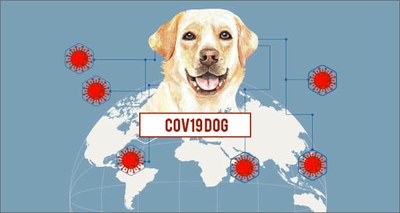COVID-19: Sensors, artificial intelligence and molecular dogs deployed to detect the virus
1/7/2021
 Trained bio-detection dogs to identify individuals infected with SARS-COV-2, chemical sensors, portable multi sensory platforms and artificial intelligence. These are some of the state-of-the-art diagnostic techniques presented during the training event of the International Society on Olfaction and Chemical Sensing (ISOCS), of which ENEA is a scientific partner. At the event, attended by 90 researchers from four continents, the causes for the loss of smell in people affected by the virus and the most innovative technologies to identify carriers were discussed.
Trained bio-detection dogs to identify individuals infected with SARS-COV-2, chemical sensors, portable multi sensory platforms and artificial intelligence. These are some of the state-of-the-art diagnostic techniques presented during the training event of the International Society on Olfaction and Chemical Sensing (ISOCS), of which ENEA is a scientific partner. At the event, attended by 90 researchers from four continents, the causes for the loss of smell in people affected by the virus and the most innovative technologies to identify carriers were discussed.
Molecular dogs, capable of operating with even greater accuracy than antigen tests, were at the top of the list.
"Trained by French veterinarians to sniff human sweat, the dogs proved to be 'infallible' in identifying carriers of the SARS-COV-2 virus in French and the Middle East airports. Italian specialists then described the numerous studies that have confirmed the validity of this approach ", Saverio De Vito, ENEA researcher, co-organizer of the event and ISOCS Educational Chair, explained.
Detection dogs, but that’s not all. To facilitate the diagnosis of the virus, researchers at the University of Rome 2 presented a method they developed - based on the use of samplers similar to those for spirometry - which could detect the presence of metabolites, typical of cells affected by the virus (or cancer) after having conducted a deep breath analysis with chemical sensors.
Considerable results were also obtained from a portable multisensory platform developed based on biomarkers present both in breath and in human biological fluids (like urine), which could identify the virus in about ten minutes with an accuracy comparable to molecular PCR tests, i.e. swabs that give results after 24 hours.
Finally, during the ISOCS course, studies showing how the loss of smell in people affected by the virus is mainly due to damage of the sensitive three-dimensional structure of the olfactory mucosa -due to the collapse of the supporting cells- were presented.
For more information please contact;
Saverio De Vito, ENEA – Development of Digital, Photovoltaic and Sensoristic Applications Laboratory, saverio.devito@enea.it
